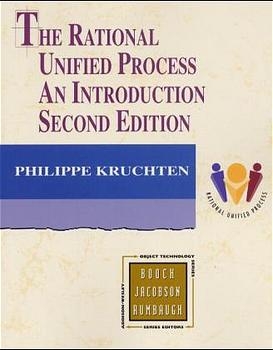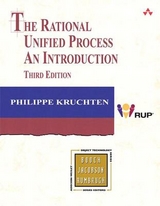
The Rational Unified Process
Addison Wesley (Verlag)
978-0-201-70710-6 (ISBN)
- Titel erscheint in neuer Auflage
- Artikel merken
This book is the fastest way to get up- and-running with Rational Unified Process 2000 -- the industry's most powerful tool for incorporating best practices into software development. Authored by RUP's Lead Architect, it reflects all the major improvements made in the newest version of RUP, including its improved support for business engineering, management of non-functional requirements, and deployment of multi-tier distributed applications. Discover how RUP 2000 can enable development teams to maximize software quality -- within predictable schedules and reasonable budgets. Understand what RUP 2000 is, how it evolved, and how it fits into the development process. Next, review the structure of RUP 2000, mastering its use throughout the entire project lifecycle. This edition includes substantial new coverage of application interface design (including Web applications); patterns and frameworks; real-time and reactive systems; lifecycle testing, and more. There are new process roadmaps that demonstrate RUP 2000 at work with many projects and technologies; as well as expanded checklists and guidelines for process artifacts, activities, and phases.
Philippe Kruchten is the lead architect of the Rational Unified Process. He has more than thirty years of experience in the development of large software-intensive systems for the telecommunications, defense, aerospace, and transportation industries. His book The Rational Unified Process: An Introduction (Addison-Wesley) has been translated into eight languages and has sold more than 160,000 copies in its two previous editions. 0201707101AB11072003
Preface.
Goals of This Book.
Who Should Read This Book?
How to Use This Book.
Organization and Special Features.
For More Information.
Second Edition.
Acknowledgments.
I. THE PROCESS.
1. Software Development Best Practices.
The Value of Software.
Symptoms and Root Causes of Software Development Problems.
Software Best Practices.
Develop Software Iteratively.
Manage Requirements.
Use Component-Based Architectures.
Visually Model Software.
Continuously Verify Software Quality.
Control Changes to Software.
The Rational Unified Process.
Summary.
2. The Rational Unified Process.
What Is the Rational Unified Process?
The Rational Unified Process as a Product.
Process Structure: Two Dimensions.
Software Best Practices in the Rational Unified Process.
Other Key Features of the Rational Unified Process.
A Brief History of the Rational Unified Process.
Summary.
3. Static Structure: Process Description.
A Model of the Rational Unified Process.
Workers.
Activities.
Artifacts.
Workflows.
Additional Process Elements.
A Process Framework.
Summary.
4. Dynamic Structure: Iterative Development.
The Sequential Process.
Overcoming Difficulties: Iterate!
Gaining Control: Phases and Milestones.
A Shifting Focus across the Cycle.
Phases Revisited.
Benefits of an Iterative Approach.
Summary.
5. An Architecture-centric Process.
The Importance of Models.
Architecture.
The Importance of Architecture.
A Definition of Architecture.
Architecture Representation.
An Architecture-centric Process.
The Purpose of Architecture.
Component-Based Development.
Other Architectural Concepts.
Summary.
6. A Use-Case-Driven Process.
Definitions.
Identifying Use Cases.
Evolving Use Cases.
Organizing Use Cases.
Use Cases in the Process.
Summary.
II. PROCESS WORKFLOWS.
7. The Project Management Workflow.
Purpose.
Planning an Iterative Project.
The Concept of Risk.
The Concept of Metrics.
What Is a Metric?
Workers and Artifacts.
Workflow.
Building an Iteration Plan.
Summary.
8. The Business Modeling Workflow.
Purpose.
Why Business Modeling?
Using Software Modeling Techniques for Business Modeling.
Business Modeling Scenarios.
Workers and Artifacts.
Workflow.
From the Business Models to the Systems.
Modeling the Software Development Business.
Tool Support.
Summary.
9. The Requirements Workflow.
Purpose.
What Is a Requirement?
Types of Requirements.
Capturing and Managing Requirements.
Designing a User-Centered Interface.
Requirements Workflow.
Workers in Requirements.
Artifacts Used in Requirements.
Tool Support.
Summary.
10. The Analysis and Design Workflow.
Purpose.
Analysis versus Design.
How Far Must Design Go?
Workers and Artifacts.
The Design Model.
The Analysis Model.
The Role of Interfaces.
Artifacts for Real-Time Systems.
Component-Based Design.
Workflow.
Tool Support.
Summary.
11. The Implementation Workflow.
Purpose.
Builds.
Integration.
Prototypes.
Workers and Artifacts.
Workflow.
Tool Support.
Summary.
12. The Test Workflow.
Purpose.
Quality.
Testing in the Iterative Lifecycle.
Dimensions of Testing.
The Test Model.
Workers and Artifacts.
Workflow.
Tool Support.
Summary.
13. The Configuration and Change Management Workflow.
Purpose.
The CCM Cube.
Workers and Artifacts.
Workflow.
Tool Support.
Summary.
14. The Environment Workflow.
Purpose.
Workers and Artifacts.
Workflow.
Summary.
15. The Deployment Workflow.
Purpose.
Workers and Artifacts.
Workflow.
Summary.
16. Typical Iteration Plans.
Purpose.
Defining the Product Vision and the Business Case.
Building an Architectural Prototype.
Implementing the System.
Summary.
17. Configuring and Implementing the Rational Unified Process.
Introduction.
The Effect of Implementing a Process.
Implementing the Rational Unified Process Step by Step.
Configuring the Process.
Implementing a Process Is a Project.
Summary.
Appendix A: Summary of Workers.
Appendix B: Summary of Artifacts.
Acronyms.
Glossary.
Bibliography.
Index. 0201707101T04062001
| Erscheint lt. Verlag | 17.4.2000 |
|---|---|
| Verlagsort | Boston |
| Sprache | englisch |
| Maße | 177 x 228 mm |
| Gewicht | 445 g |
| Themenwelt | Informatik ► Software Entwicklung ► Objektorientierung |
| ISBN-10 | 0-201-70710-1 / 0201707101 |
| ISBN-13 | 978-0-201-70710-6 / 9780201707106 |
| Zustand | Neuware |
| Informationen gemäß Produktsicherheitsverordnung (GPSR) | |
| Haben Sie eine Frage zum Produkt? |
aus dem Bereich



